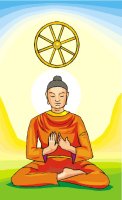
Worksheets and No Prep Teaching Resources
Reading Comprehension Worksheets
World Religion

World Religion
 Worksheets and No Prep Teaching Resources Reading Comprehension Worksheets World Religion |
 World Religion |
| edHelper's suggested reading level: | grades 6 to 8 | |
| Flesch-Kincaid grade level: | 6.47 |
|
What Is Buddhism?
By Colleen Messina |

|
 1 Sometimes having everything in the world isn't enough! It's what is inside you that is most important. A prince discovered this 2,500 years ago. His name was Siddhartha Gautama, and he was born in the country we now call Nepal. His discovery led to the founding of Buddhism.
1 Sometimes having everything in the world isn't enough! It's what is inside you that is most important. A prince discovered this 2,500 years ago. His name was Siddhartha Gautama, and he was born in the country we now call Nepal. His discovery led to the founding of Buddhism. |
Create Weekly Reading Books
Prepare for an entire week at once! |
| Leave your feedback on What Is Buddhism? (use this link if you found an error in the story) |
 |
World Religion
|
 |
Social Studies
|